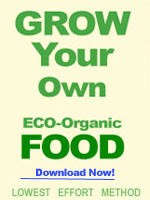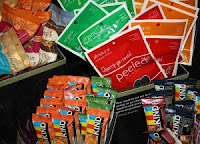Alex Pietrowski, Contributor
Activist Post
Greed and power in the food industry is turning a trip to the grocery store into an objectionable experience, as processed and factory foods are further pushed onto the unwitting public.
On the positive side, however, most of us now have plenty of organic options, providing we know where to shop and how to find the good stuff. From fresh organic produce, to organic and compassionately farmed animal products, to a variety of delicious organic packaged foods, it is now easier than ever to eat healthy and stay away from unwanted pesticides, antibiotics, GMO ingredients, and synthetic additives in our food.
And now that Proposition 37 in California to label GMO foods has been defeated by the food industry and a sleeping populace, it is more important then ever to know how how to access and support the organic food movement. In a big way, your life depends on it.
Consumers must be prepared to demand and fight for high-quality organic options in our supermarkets, or we will be faced with a further degradation of production standards, questionable business practices, and conflict of interest matters.
Big Agra Conflict of Interest
A recent issue raised by various organic food industry watchdogs has been the presence of conflict of interest that has influenced decisions on what food additives are approved for use in organic packaged products. US organizations, such as the Cornucopia Institute and Center for Food Safety, have recently raised the issue of Big Agra business encroaching on the independent oversight that the US National Organic Standards Board (NOSB) has over what synthetic items can be added to the approved National List. This list includes processed synthetic items and processes that are approved for use in organic packaged products. The following video from Cornucopia Institute provides a thorough overview regarding this issue:
A conflict of interest question has been raised regarding who makes the decisions about what contractors and consultants conduct technical or TAB reviews of materials on the National List of approved organic ingredients. Currently, the NOSB does not hold the final decision in this; instead, the USDA’s National Organic Program (NOP), the designated federal officer that participates in NOSB meetings, and the USDA Office of Ethics are said to carry an unethical influence over these decisions.
 The decisions of the NOSB significantly affect the direction of the organic industry and what synthetic items are actually considered acceptable organic food components. Questionable items are already approved, such as the food additive Carrageenan, which was re-approved for use in organic food processing as of the Spring 2012 NOSB meeting.
The decisions of the NOSB significantly affect the direction of the organic industry and what synthetic items are actually considered acceptable organic food components. Questionable items are already approved, such as the food additive Carrageenan, which was re-approved for use in organic food processing as of the Spring 2012 NOSB meeting.
“Degraded carrageenan,” which is present in all food-grade carrageenan, is classified as a “possible human carcinogen” by the International Agency for Research on Cancer of the World Health Organization (WHO) and the National Academy of Science in United States. – Cornucopia Institute
Who Owns Organic
It can be quite shocking to realize that we’re at a stage of having a “possible human carcinogen” approved as an ingredient in our organic products. Perhaps as awareness of this grows, concerned industry players, consumers and government officials will implement new checks and balances to ensure that less conflict of interest exists in the NOSB in the US, and in similar organic industry authorities worldwide. Industry oversight will grow in importance now that most non-organic, all-American brands, many of which are supporting Monsanto’s no GMO labeling efforts, are the same companies that have been heavily investing in the organic industry over the last 15+ years.
Some of the big food companies that have given money to the [GMO] anti-labeling cause also own organic brands, such as Kellogg Co., which owns the Kashi cereal brand, Dean Foods Co., owner of the Horizon organic dairy line and J.M. Smucker Co., which owns several organic brands. – Wall Street Journal
Here’s a PDF of the top food companies in the US and their ownership ties to well-known organic brands (as of June 2009): http://www.cornucopia.org/wp-content/themes/Cornucopia/downloads/OrganicT30J09.pdf
Click here to download a short video created by Dr. Phil Howard, Assistant Professor at Michigan State University about who owns some of the more well-known organic brands.
How to Shop Organic
Let’s agree that buying food is much more complicated than it used to be, especially for the aware, health-conscious individual. There are more choices than ever, but these choices come from fewer companies. For shoppers, it is vitally important to understand the labeling process currently employed in the organic food industry. This is why people who want to label GMO foods are so passionate about this cause: labels are one of a few ways, if not the only way, that consumers can make informed decisions about what food they buy.
The USDA’s NOP offers some insight on its website about the labeling requirements of organic products, which can be viewed in the Labeling Organic Products PDF. Here’s a quick video with Anne Lappe, author of Grub: Ideas for an Urban Organic Kitchen, offering an overview of how to identify organic foods in stores:
In the video, Lappe mentions that buying organic produce is easy – it’s either organic or not. But what if your organic produce selection is limited? Or you’re on a budget, and shopping all organic is breaking the bank. Here’s a quick review of what fresh produce is typically most heavily treated with pesticides and which is not: http://www.ewg.org/foodnews/summary/
Here is another article with some insight regarding organic dairy, meat and seafood. http://www.motherearthliving.com/food-for-health/what-we-eat.aspx
Think Local
If you already buy organic products or just want to eat healthier, don’t get discouraged by this article. It is a resource. Take this opportunity to learn from the wealth of information available here, and start making even better food choices. In our world, it is difficult to be 100% organic. But there are ways you can move closer toward this goal. Support smaller organic food producers and local farms. Eat fresh and raw foods. Start an organic garden or become involved in a community urban farming project. And stay informed and educated, so YOU are the one who decides on what food ends up on your dinner table.
Sources:
http://www.cornucopia.org/2012/05/wildfires-rage-at-new-mexican-organic-meetings/
http://foodbabe.com/2012/05/22/watch-out-for-this-carcinogen-in-your-organic-food/
http://www.centerforfoodsafety.org/wp-content/uploads/2012/10/CFS-NOSB-Comments-24-Sept-2012.pdf
http://www.cornucopia.org/who-owns-organic/
http://www.motherearthliving.com/food-for-health/what-we-eat.aspx
http://www.cornucopia.org/who-owns-organic/
http://www.beyondpesticides.org/dailynewsblog/?p=7580
http://www.cornucopia.org/Cultivator-Summer-2012.pdf
http://online.wsj.com/article/SB10001424052970203400604578073182907123760.html
This article first appeared at Waking Times
Alex Pietrowski is an artist and writer concerned with preserving good health and the basic freedom to enjoy a healthy lifestyle. He is a staff writer for WakingTimes.com, and an avid student of Yoga and life.
var linkwithin_site_id = 557381;
linkwithin_text=’Related Articles:’




Be the first to comment on "The Fight for Real Organic Food Continues"